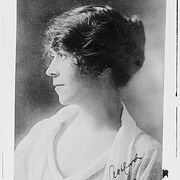Daisy Ashford (1) (1881–1972)
Auteur de The Young Visiters
Pour les autres auteurs qui s'appellent Daisy Ashford, voyez la page de désambigüisation.
A propos de l'auteur
Crédit image: George Grantham Bain Collection, Library of Congress, Prints and Photographs Division, Reproduction Number LC-DIG-ggbain-30073
Œuvres de Daisy Ashford
Oeuvres associées
Étiqueté
Partage des connaissances
- Nom légal
- Devlin, Margaret Mary Julia Ashford
- Autres noms
- Devlin, Daisy
- Date de naissance
- 1881-04-03
- Date de décès
- 1972-01-15
- Sexe
- female
- Nationalité
- UK
- Lieu de naissance
- Petersham, Surrey, England, UK
- Lieu du décès
- Norwich, Norfolk, England, UK
- Lieux de résidence
- Petersham, Surrey, England, UK
Reepham, Norfolk, UK
Lewes, Sussex, England, UK
Bexhill, Sussex, England, UK
London, England, UK - Études
- at home
- Professions
- novelist
Playwright
short story writer
hotel proprietor
secretary - Courte biographie
- Daisy Ashford was the pen name of Margaret Ashford Devlin, the daughter of a government official. She was educated largely at home with her sisters. A child prodigy, she began writing or dictating stories as a very young child though she was not published until years later. In 1920, she married James Devlin and settled in Norfolk, at one time running the King's Arms Hotel in Reepham. She was best known for The Young Visitors, or Mr. Salteena’s Plan, a novella about upper-class society of late 19th-century England. It was published in 1919 and is said to have been written when she was only 9 years old. The Young Visitors was adapted for the stage several times, including as a musical comedy.
Membres
Critiques
Listes
Prix et récompenses
Vous aimerez peut-être aussi
Auteurs associés
Statistiques
- Œuvres
- 5
- Aussi par
- 1
- Membres
- 613
- Popularité
- #41,002
- Évaluation
- 3.8
- Critiques
- 20
- ISBN
- 55
- Langues
- 5















Or when Ethel announces that she's almost ready to go out, since she had her bath last night and doesn't need to wash much this morning and Bernard replies, "No dont... you are fresher than the rose my dear no soap could make you fairer."
But, all things told, it really provides no more than a few minutes' amusement, and it is about as short as it should be.… (plus d'informations)